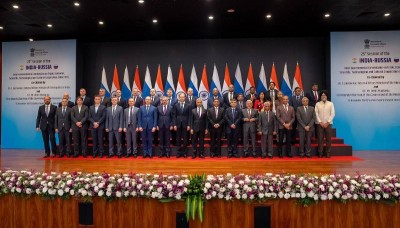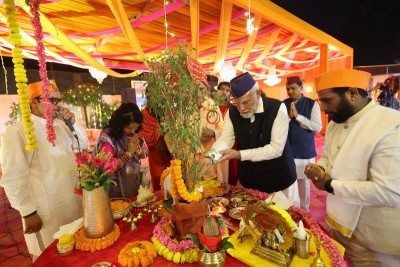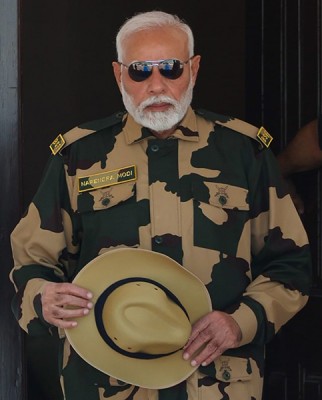
Chhattisgarh: Speed Breakers
On August 23, 2015, an assistant platoon commander of the Chhattisgarh Special Task Force (STF), K.P. Singh, was killed and a constable, Santosh Yadav, was injured, when Maoists ambushed an STF patrol team deployed to secure a stretch of the newly laid National Highway 30 in the Darbha region of Bastar District. After the ambush, the Maoists damaged the highway and traffic was affected.
Earlier, on May 29, 2015, a day before Union Home Minister (UHM) Rajnath Singh's visit to Chhattisgarh, one trooper of the Chhattisgarh Armed Force (CAF) was killed and another two were critically injured in an IED blast triggered by the Maoists in Sukma District. The CAF personnel were deployed on duty for protection of workers at a construction site near Dharampenta village at Kistaram.
The Maoists are using every tactic in the book to put speed breakers in the construction of roads in areas under their disruptive dominance. According to South Asia Terrorism Portal (SATP), Maoists in Chhattisgarh have attacked a construction site or SFs deployed to provide security to road construction activities at least seven times in 2015, and had done so at least six times in 2014; on five occasions in 2013; nine in 2012; and at least three in 2011. In the worst such attack on March 11, 2014, 15 SF personnel were killed in an ambush by Maoists in the Darbha Valley area of Bastar District, where Maoists had earlier killed Mahendra Karma and others (part of a Congress Party convoy) on May 25, 2013. The team was engaged in an area domination exercise to sanitise the area for troop movements and also to provide security to road construction workers.
Not surprisingly, the performance of the Road Requirement Plan (RRP) in Chhattisgarh is the worst among all Maoist-affected States. RRP is now being mostly referred to as RRP phase one, with the Union Government coming up with a second phase. RRP-I was approved in February, 2009 for improvement of road connectivity in 34 extremely Left Wing Extremism (LWE)-affected Districts in 8 States: Andhra Pradesh, Bihar, Chhattisgarh, Jharkhand, Madhya Pradesh, Maharashtra, Odisha and Uttar Pradesh. RRP-I envisaged the development of 1,126 kilometres of National Highways and 4,351 kilometres of State Roads (total 5,477 kilometres), at a cost of INR 7,300 crore by March 2015. As of July 31, 2015, only 3,765 kilometres of road under the Plan had been completed. Chhattisgarh has been the worst performer under the plan, completing under 49 per cent of the 2,019 kilometres sanctioned. The delay has primarily been ascribed to Maoist violence. According to the Ministry of State for Road Transport & Highways (MORTH), RRP-I is likely to be substantially completed by March 2016, with the exception of about 500 kilometres, which are yet to be awarded in the States of Chhattisgarh and Jharkhand.
On August 7, 2015, Chief Minister Raman Singh stated that Naxalism (Left Wing Extremism) was putting a huge dent into Chhattisgarh's GDP, as the Government had to spend a huge amount of money towards rebuilding infrastructure and inducting Police personnel:
Naxal problem left a huge impact on our GDP. When I took over as the CM, there were around 23,000 policemen in our force. We had to invest a huge amount in recruiting new force, which now stands at around 67,000 personnel... In Chhattisgarh, it is a monumental task for us to build infrastructure (due to Naxalism). For example, to build a 17-kilometre long road, it took two years and lives of five jawans [troopers]. It takes too much of money to rebuild roads and bridges, which Naxals frequently blow up.
Given the security situation in Chhattisgarh, it is nobody's case that road construction is not difficult. The difficulty levels, however, are not the same in all areas where roads are to be constructed. The Comptroller and Auditor General's (CAG's) report released on July 26, 2015, notes that the Public Works Department (PWD) of Chhattisgarh [RRP is implemented by MORTH through PWDs of respective States], had completed only 31per cent of the work undertaken between 2009-14 under RRP [till March 2014, not to be confused with MORTH data as it is till July 31, 2015]. Under this special programme, 53 works comprising length of 2021.73 kilometres were sanctioned for 2897.09 crore in Chhattisgarh during 2009-14. The development of the roads under the programme was scheduled to be completed by March 2015. However, till March 2014, the physical progress was 618.34 km (31 per cent) and financial progress was 805.04 crore (27 per cent). The works under RRP were divided into three categories: Category-I: Roads where the agencies may be able to carry out the construction without much security arrangement; Category-II: Roads where agencies may face some sort of problem and need some protection for carrying out the work; Category-III: Roads where there is high risk of security and execution activities need special protection from the State Government.
Regarding the slow pace of work on the project, CAG observed:
...out of total number of 19 road works selected under Category-I, only 12 works could be completed by the department. Balance seven works which were to be completed by 2011-12 remained incomplete even after two-three years of commencement. The percentage of progress of these seven works ranged between 21 and 97 per cent.
Out of these, in two works (Wadrafnagar-Janakpur-Balangi road and Bishunpur-Surajpur-Odgi road) the delay was due to slow progress by the contractor, in one case (Balarampur-Chando-Samri Road) the slow progress was due to burning of plant and machinery by the Naxalitesand in case of other work (High level bridge at Balrampur-Chando-Samri road) work order was issued in March 2014, which was 40 months after receipt of sanction (November 2010), as the finalisation of tender could be done after twelve bids. No specific reason for delay could be ascertained in remaining three works.
In Category-II, out of nine road works, two road works were completed and seven works are under progress. These seven works were to be completed by 2012-13, however, the progress as of March 2014 ranged between 16 and 48 per cent. The reason for slow progress in respect of three works was due to burning of plant and machinery byNaxalites. In one case (ChotebetiaRengawahi-Tarawaki Road) the delay was due to pending forest clearance. Out of remaining three, in case of two roads the delay was due to slow progress by the contractor and in one case (Jagdalpur-Konta Road, New NH-30 JeeramTongpal) no reason for delay could be ascertained from the records.
In Category-III road works, the progress in respect of nine roads ranged from five to 51 per cent and progress of two other roads was more than 80 per cent. Eleven works were at the tender stage as no agency participated in the bidding process even after issue of several bids and in respect of three other road works, the tenders was not yet finalised.
Thus, the department could not complete the roads selected under Category-I and II within the stipulated period of contract even though security perception was not of higher risk. The progress of Category-III road works was slow, which resulted in failure to improve connectivity in the LWE affected areas.
Officials in Chhattisgarh, however, insist that things are likely to change for better. R.K. Vij, Additional Director-General of Police (Anti-Maoist Operations), disclosed, "We are now deploying our companies only to provide dedicated security to road construction. That wasn't so earlier." In the most sensitive zones, where private contractors or public works department officials may fear to take up projects, the security forces will themselves do most of the construction under the supervision of government engineers, sources added. Thus, it is the Police who will be building an all-weather road connecting Injaram with Bhejji and Chintagupha in the rebel heartland of Sukma. News reports indicate that camps housing one company each have been set up every 5 kilometres along the 56 kilometre Dornapal-Chintalnar-Jagargunda route. The Sukma-Konta stretch of NH221 is to have the heaviest deployment - one company every two or three kilometres, to patrol the area and oversee the completion of the road.
Among other infrastructure development projects, Chhattisgarh is set to complete the process of constructing 50 'fortified' Police Stations in the Bastar region by December this year, out of the total of 75 such Police Stations sanctioned in Chhattisgarh. The State Police Housing Corporation Managing Director, D.M. Awasthy, on August 30, 2015, disclosed that work on 25 fortified Police Stations had been completed, while 15 Police Stations were nearing completion.
Further, to strengthen the communication network in Maoist areas, the Union Telecom Ministry has approved 497 mobile towers for Naxalite-affected areas. According to State Chief Secretary Vivek Dhand, 465 mobile towers have already been erected out of which 415 have also started operating, while the installation of the remaining 32 towers is in progress, and would be completed by November 2015.
As the campaign against the Maoists continues, the development and protection of critical infrastructure, especially road connectivity and communications, is of vital importance, both for the viability of anti-Naxalite operations and to bridge the development gap with other regions. Chhattisgarh has lagged behind for too long. The current reversals that the Maoists have suffered are an unprecedented opportunity to address the gigantic security and developmental deficits in the areas worst afflicted by the Left Wing insurgency in India.
Support Our Journalism
We cannot do without you.. your contribution supports unbiased journalism
IBNS is not driven by any ism- not wokeism, not racism, not skewed secularism, not hyper right-wing or left liberal ideals, nor by any hardline religious beliefs or hyper nationalism. We want to serve you good old objective news, as they are. We do not judge or preach. We let people decide for themselves. We only try to present factual and well-sourced news.







